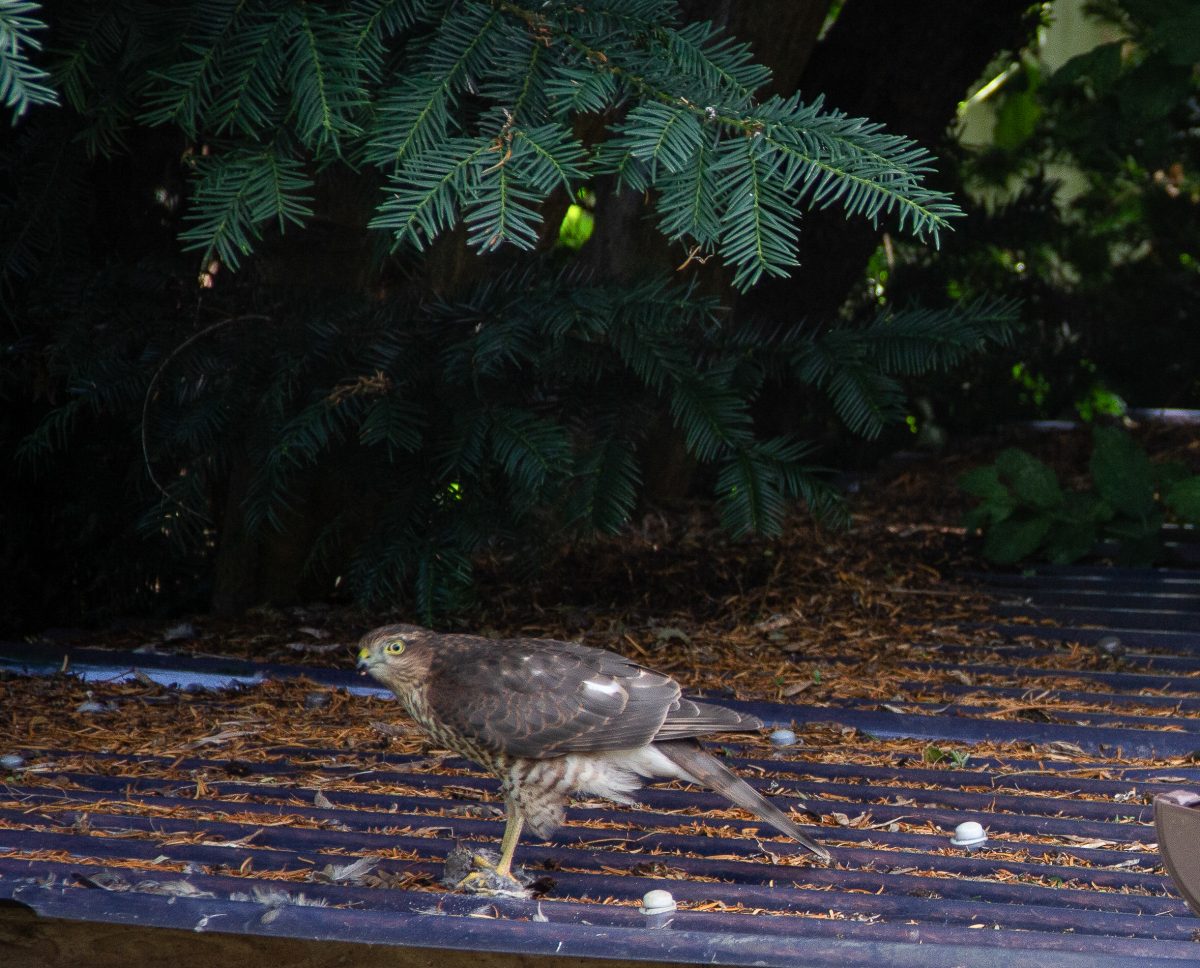TASK:
Choose a simple gesture that you or another subject can perform. For example, a hand movement, pose, or facial expression.
Represent the same gesture through static and moving media: for example a photograph or drawing, and moving image or a short animation.
Compare the results. Are there different aspects of the gesture that you are able to capture in each of these media?
Write a short caption for each that tries to capture these differences.
For this project I wanted to use some footage that relates to my SYP body of work about wildlife in my garden, and to see what the different technical as well as visual challenges are in using low resolution clips from my old iPhone.
The original footage for this project was video of a Sparrowhawk ripping up and eating a pigeon on the roof of our bicycle shed. This was taken on an old iPhone 5s at quite some distance through a window – as my prime aim was to record the movement for animation I did not want the Sparrowhawk to notice me and fly away.
From the original unedited video I also captured some ‘keyframes’ and processed these in Photoshop using Topaz AI sharpening and other tonal and colour adjustments.
Both video and still images can have a variety of styles and purpose. But often:
Moving image has transitory focus on an individual moment in time, or sequence of moments, but can show more clearly before and after events. They can also show process and change: gesture, strength, weight, pulling etc. Even if each frame is blurred, the viewer can get the sense of the whole. Alternatively clips and clip sequences can be selected to purposely highlight ambiguity.
Still images can leave before and after ambiguous. They can capture and emphasise the ‘decisive moment’ of drama, leaving cause and/or effect open for the viewer to think about. But they can also blur movement or use framing, composition and juxtaposition to creat a narrative of a process over time.
Boundaries may be technologically blurred in contemporary digital processes. Digital composites, collage and sequences of still images can create narrative. Very short moving image sequences can loop to focus on one event and leave before and after open to interpretation.
Sparrowhawk: iPhone video
Moving image has transitory focus on an individual moment or narrative sequence of moments in time, but (if this is intended) can show clearly before and after events, causes and consequences and the ways in which postures, expressions and moods change over time.
The original video is quite blurred. Processing in Premiere : sharpening, increasing colour and tone contrast, cropping and vignetting gives a much clearer view of what is happening as a basis for eg rotoscoping.
Visually the resulting video enables a study of the movement over time – gesture, strength, weight, pulling etc.- as the carcass is ripped up, the ways in which the talons are moved and force with which they push the body up to tear off bits of flesh, and the beak as it tosses the bits into the mouth. Even if each image is blurred, the viewer can get the sense of the whole.
But technically there is no way in which I could make the original iPhone video into an acceptable clip of wildlife video footage – except as a good basis for rotoscoping, or as a dark eerie layer for a composite video.
I captioned this ‘the carcass’ because this is the most blurred, blow out and unclear element in the footage, to highlight what the more obvious Sparrowhawk is doing.
Sparrowhawk: still frame export processed in Photoshop
Still images may attempt to capture a ‘decisive moment’ of drama which can either imply or leave ambiguous what happens before and/or after. Depending on the purpose the image may be informative and illustrative of a particular common or unusual feature. They may clearly indicate eg through juxtaposition and leading composition lines the cause and/or effect of an action, or leave this open for the viewer to think about.
The gallery on the left shows a series of frames captured from the edited video – none of them are sharp, but some of the movement blurring is quite interesting.
The best result (below) was edited from one of the sharpest images the original video adding Topaz AI sharpening and tonal and colour e]adjustments in Photoshop. This captures the fierce look in the Sparrowhawk’s eye as it checks what is happening around it. It is still not completely sharp – and cannot be made so. But I could process it further as an interesting more impressionistic image to bring up the feathers scattered around and the leftovers of the carcass under its talons.
This one of many possible ‘decisive moments’ could be titled something like ‘Guilty’, ‘Caught in the Act’, or ‘Suspicious’.





